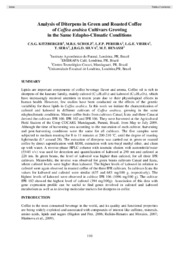Analysis of Diterpens in Green and Roasted Coffee of Coffea arabica Cultivars Growing in the Same Edapho-Climatic Conditions.
Analysis of Diterpens in Green and Roasted Coffee of Coffea arabica Cultivars Growing in the Same Edapho-Climatic Conditions.
Author(s): KITZBERGER, C. S. G.; SCHOLZ, M. B. S.; PEREIRA, L. F. P.; SERA, T.; SILVA, J. B. G. D.; BENASSI, M. T.
Summary: Lipids are important components of coffee beverage flavor and aroma. Coffee oil is rich in diterpens of the kaurane family, mainly cafestol (C20H28O3) and kahweol (C20H26O3), which have increasingly received attention in recent years due to their physiological effects in human health. However, few studies have been conducted on the effects of the genetic variability for those lipids in Coffea arabica. In this work we initiate the characterization of cafestol and kahweol in different cultivars of Coffea arabica, growing in the same edaphoclimatic conditions. Mature coffee fruits from cultivars Catuaí, Icatu and three Catucaí derived the cultivars IPR 100, IPR 102 and IPR 106. They were harvested at the Agricultural Field Station of the Coop COCARI, Mandaguari, Paraná, Brazil, from May to July 2009. Although the time of harvesting was according to the maturation of each cultivar, harvesting and post-harvesting conditions were the same for all cultivars. The five samples were subjected to medium roasting for 8 to 11 minutes at 200-210 °C, until the degree of roasting light/media (L* around 28). The extraction of diterpens was carried out in green or roasted coffee by direct saponification with KOH, extraction with terc-butyl methyl ether, and clean up with water. A reverse-phase HPLC column with isocratic elution with acetonitrile/water (55/45 v/v) was used for detection and quantification of kahweol at 290 nm and cafestol at 220 nm. In green beans, the level of kahweol was higher than cafestol, for all three IPR cultivars. Meanwhile, the inverse was observed for green beans cultivars Catuaí and Icatu, where cafestol levels were higher than kahweol. The higher levels of kahweol in relation to cafestol were again observed in roasted coffee of the three IPR cultivars. In cultivars Icatu the values for kahweol and cafestol were similar (635 and 683 mg/100 g, respectively). The highest levels of kahweol were observed in cultivar IPR 106 (1096 mg/100 g). The cultivar IPR 102 showed the highest level of cafestol (394 mg/100g). Association of this data with gene expression profile can be useful to find genes involved in cafestol and kahweol metabolism as well as to develop molecular markers for diterpens in coffee.
Publication year: 2011
Types of publication: Paper in annals and proceedings
Unit: Embrapa Coffee
Keywords: Coffea Arábica, Cultivars
Observation
Some of Embrapa's publications are published as ePub files. To read them, use or download one of the following free software options to your computer or mobile device. Android: Google Play Books; IOS: iBooks; Windows and Linux: Calibre.
Access other publications
Access the Agricultural Research Database (BDPA) to consult Embrapa's full library collection and records.
Visit Embrapa Bookstore to purchase books and other publications sold by Embrapa.

